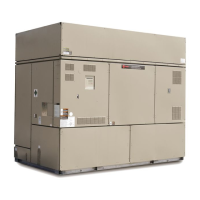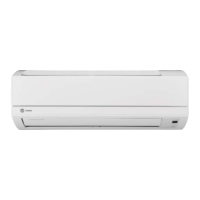Unit Startup
RT-SVX24J-EN 11 5
System Airflow Measurements
Constant Volume Systems
1. Ensure that the “System” selection switch at the
remote panel is in the “Off” position and the “Fan”
selection switch for constant volume units is in the
“Auto” position.
2. Close the disconnect switch or circuit protector switch
that provides the supply power to the unit terminal
block or the unit mounted disconnect switch.
HIGH VOLTAGE IS PRESENT AT TERMINAL BLOCK OR
UNIT DISCONNECT SWITCH.
3. Turn
the 115 volt control circuit switch and the 24 volt
control circuit switch to
the “On” position.
4. Open the Human Interface access door, located in the
unit control panel, and press
the SERVICE MODE key to
display the first service screen. Refer to the latest
edition of the appropriate programming manual for CV
applications for the SERVICETEST screens and
programming instructions.
5. Use Table 37, p. 110 to program the Supply Fan for
operation by scrolling through the displays.
6. Once the configuration for the Fan is complete, press
the
NEXT key until
the LCD displays the “Start test in
__Sec.” screen. Press the + key to designate the delay
before the test is to start.This ser vice test will begin
after theTEST START key is pressed and the delay
designated in this step has elapsed. Press the ENTER
key to confirm this choice.
7. Press theTEST START key to start the test. Remember
that the delay designated in step 6 must elapse before
the fans will begin to operate.
8. With the system in the SERVICE MODE and the supply
fan rotating in the proper
direction, measure the
amperage at the supply fan contactors. If the
amperage exceeds the motor nameplate value, the
static pressure is less than design and the airflow is too
high. If the amperage is below the motor nameplate
value, static pressure may be too high and CFM may be
too low.To determine the actual CFM (± 5%);
a. Measure the actual fan RPM
b.
Calculate theTheoretical BHP
Actual Motor Amps X Motor HP
Motor Nameplate Amps
c. Plot this data onto the appropriate Fan Performance
Curve beginning with Figure 62, p. 98. Where the
two points intersect, read straight down to the CFM
line.
Use this data to assist in calculating a new fan drive if the
CFM is not at design specifications.
An alternate method with less accuracy is to measure the
static pressure drop across the evaporator coil.This can be
accomplished by;
a. drilling a small hole through the unit casing on each
side of the coil.
Note: Coil damage can occur if care is not taken when
drilling holes in this area.
b. Measure the difference between the pressures at
both locations.
c. Plot this value onto the appropriate pressure drop
curve beginning with Figure 71, p. 118. Use the data
in Table 40, p. 125 (Component Static Pressure
Drops) to assist in calculating a new fan drive if the
CFM is not at design specifications.
d. Plug the holes after the proper CFM has been
established.
9. Press the STOP key at the Human Interface Module in
the
unit control panel to
stop the fan operation.
Variable Air Volume Systems
1. Ensure that the “System” selection switch at the
remote panel is in the “Off” position.
2. Close the disconnect switch or circuit protector switch
that provides the supply
power to the unit terminal
block or the unit mounted disconnect switch.
WARNING
Hazardous Voltage!
Disconnect all electric power, including remote
disconnects before servicing. Follow proper lockout/
tagout procedures to ensure the power can not be
inadvertently energized. Failure to disconnect power
before servicing could result in death or serious injury.
WARNING
Live Electrical Components!
During installation, testing, servicing and
troubleshooting of this product, it may be necessary to
work with live electrical components. Have a qualified
licensed electrician or other individual who has been
properly trained in handling live electrical components
perform these tasks. Failure to follow all electrical
safety precautions when exposed to live electrical
components could result in death or serious injury.

